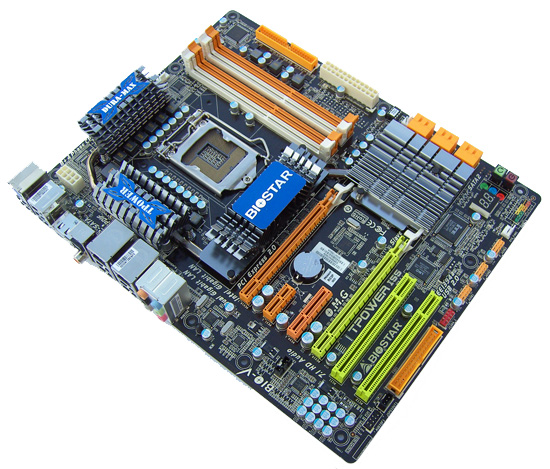Biostar TPower i55 – Super Middle Weight Contender
by Rajinder Gill on November 25, 2009 12:00 PM EST- Posted in
- Motherboards
After our review of the MSI GD-65, it was clear that we had a very good board on our hands but one that was lacking the final layers of polish that segregate the really good from the very best. Needless to say there are other candidates available that may fit the bill or improve in areas where the MSI GD-65 is lacking. Biostar thinks one of those options is the TPower i55. The TPower i55 comes in around $180, which is around $25 higher than MSI’s GD-65. However, we think Biostar is aiming to upstage the top-end P55 boards by offering similar overclocking features, quality, and performance at a lower price. Of course, $180 is encroaching on the lower-end X58 price territory, so Biostar has a difficult sale on their hands. However, we think Biostar hit their target for the most part.

Overview/Conclusion
We’ve thrown our standard test suite at the TPower i55, testing gaming performance and day to day usability. In terms of overall compatibility, this board came out of the blocks well ahead of what you expect from a tier “B” supplier. All of our testing was performed on the current public BIOS and completed without a glitch. It’s the first time in a long time we’ve not had to request fixes for peripherals or BIOS issues/tweaks to complete a benchmark, a welcome change indeed! It not the perfect BIOS in every regard, but this is one extremely solid board when it comes to stability and compatibility.
It’s when you look past the BIOS related stuff that you’ll probably find a couple of things to groan about. Firstly, the lack of on-board fan headers; 3 in total, one of which is for the CPU, while one of the others becomes obscure as soon as you place a long GPU like the 4870X2 in the primary PEG slot. The remaining header will likely be used to cool the onboard heatsink array, leaving no additional options for case fans. .
Given how sensitive overclockers are about component/case operating temperatures, we find the limited fan header count an odd choice on BIOSTAR’s part. After all, high temperatures and overclocking generally don’t mix very well.
The second gripe is one you’ll only encounter if you change video cards or add-in cards often, so you could say we’re nit-picking. The PCI/e retention latches are a royal pain to unlock once a card is inserted in the slot. We found our 4870X2 was un-removable by hand unless we used a pair of long nose pliers to wedge the retention latch away from the card. It’s not a deal breaker, but there are better ways of latching cards into slots as ASUS has shown us recently. If you have to remove such a card when the board is placed in a case, we’re sure it'll be accompanied with a fair share of choice words.
Lastly, we were going to add the lack of a CMOS clear button on the rear I/O panel to the list of gripes but found we did not have to use the onboard jumper at all during the test period. BIOSTAR has done an incredible job at BIOS recovery in the event of a failed overclock or incorrect setting. Our test board recovered from everything we threw at it, coming back to post in safe mode so that the offending BIOS setting could be corrected with minimal trouble.
On the overclocking front, getting 2000MHz+ memory speeds is relatively straight forwards (with the right CPU and memory kit!) other than the fact we had to change tRFC manually to 80 as the BIOS defaults to a tight 74 when left to its own devices using our Corsair 2200 8-8-8-24 4Gb kit (could be down to the SPD). Our GSkill and Kingston DDR3-2133 8GB C9 kits operated fine with the tRFC at the default 74. Running 2000+ memory speeds always requires a little end-user leg work on these platforms, so simply changing four voltages and setting primary memory timings is certainly nothing to moan about.
The basic essentials like S3 sleep mode properly resuming, even with BCLK’s north of 215MHz, worked extremely well on this board. This is a big plus for those that like to utilize sleep states with the boards overclocked. Automated overclocking is also available for users who prefer one touch overclocking. Three presets are available, which raise BCLK by up to 12MHz (145BCLK effective with 24x Turbo Mode on the 750 that resulted in 3.4GHz speeds at full load) at the touch of a button. Not the most impressive increase but voltage ramping is very moderate and we found the presets to be completely stable on our test hardware without any compatibility problems.
If you are considering one of the top-end P55 boards from ASUS, Gigabyte, MSI or EVGA; we think you should take a hard look at the TPower i55 before you spend more money elsewhere. Other than the fan header count, it does not appear to give up anything to more expensive boards when faced with the rigors of daily use or when overclocking on air or water. Against mid-range boards, the BIOSTAR appears to be a little better suited for pushing hard by virtue of its over engineered power rails (something the lower priced boards tend to skimp on) and component quality. To sum it up, the TPower i55 is not quite perfect, but it’s close enough for most. Call us impressed.










39 Comments
View All Comments